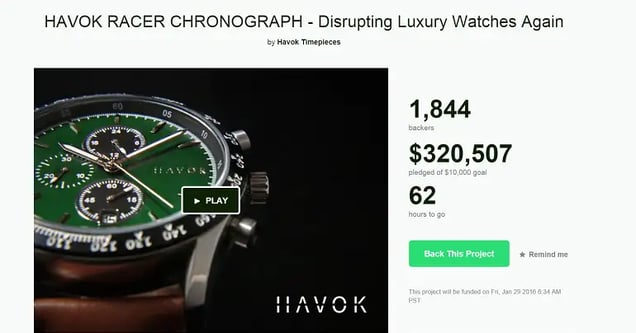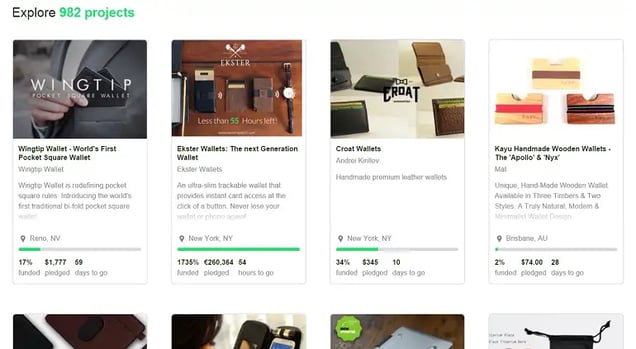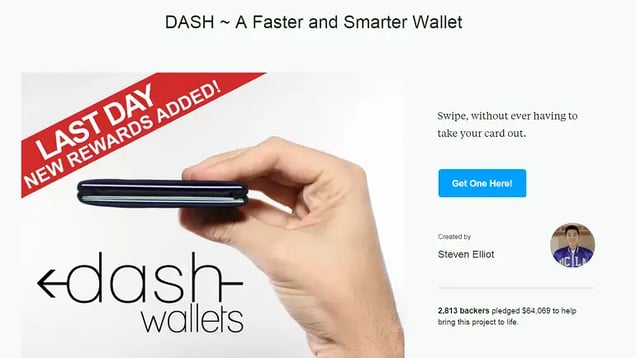23-year-old Steven Elliot Ng has launched 10 successful projects on Kickstarter, crowdfunding over $1.5 million since 2012.

His most recent project, the Havok Racer Chronograph luxury watch, launched on November 30, 2015. It reached its $10,000 goal in less than an hour. Steven ended that campaign with over $320,000 in crowdfunding. What’s his secret sauce?

Steven’s love for Kickstarter began in 2012 during his sophomore year at UCLA. He was studying for an economics degree, but never really connected to his classes. Then his older brother got curious about Kickstarter, and asked Steven if he wanted to help launch his idea, the Halo Belt. It’s an LED light that’s worn on the waist to keep you safe when biking at night.
Steven agreed, and the first campaign was fully funded. In fact, it exceeded their $5,000 goal by 940%. This inspired Steven to launch a Kickstarter project of his own six months later. He realized it was a great way to get ideas off the ground quickly… and he figured he knew the best way to do it.
In 2012, Kickstarter was still pretty new to people, and when Steven looked up “wallets”, he found two or three projects that were live (compared to the 982 wallet projects on the platform today).

He was interested in men’s style, and figured he knew enough to make a wallet that was “cooler” than what was currently available. In Steven’s opinion, everything available was too bulky. He wanted something minimalistic that gave men quick access to all their cards.
The only catch was that Steven didn’t know anything about making products. He made his first prototype out of sock fabric that he cut and stitched himself.
After six months of prep work, Steven launched his wallet – called Dash 1.0 – on Kickstarter with a goal of $10,000. The date was December 5, 2012. He reached his goal in his first week.

When the campaign ended, Steven had sold 2,813 units and collected $64,049. Over 50% of this went toward his rent and tuition at UCLA.
He was 19.
After Dash 1.0 was delivered to customers, he started getting questions about when he was going to build a new version.
“What new version!?”
Realizing the demand, Steven got to work with new iterations of Dash. He designed and manufactured Dash 2.0, Dash 3.0, and Dash 4.0.
He used his skills to expand into different verticals. In 2015 he collaborated with lifestyle brand SLUGHAUS to launch Bullet, the world’s smallest LED flashlight.
Together they crowdfunded over $200,000 after launching in December 2015. Their goal: $10,000. He also crowdfunded $443,777 when he launched a luxury minimal watch on Kickstarter in January 2015.

Becoming the ‘next’ Steven
Steven’s expertise has grown, but his process remains the same. These are his actionable steps to launching a winning crowdfunding campaign.
Step One: Identify a ‘Take To Market’ idea
Steven emphasized that the first step is always product research. Entrepreneurs have to understand the improvements people want in their current products. This can be discovered through crawling product review websites, reading consumer forums, and trolling the comments section on blogs.
If you find a lot of people saying, “This wallet would be great if it had X feature,” you’ve found your opportunity.
Takeaway: You need more than a great idea; you need to know people are looking for your idea. Get confirmation through research before moving forward.
Step Two: From concept to creation
Steven’s economic classes hadn’t prepared him for running any type of business, let alone Kickstarter campaigns. He had never sketched a design or created a prototype before. He hadn’t used Photoshop and couldn’t edit or shoot video. He had zero experience in marketing. But Steven turned to internet tutorials to get these skills quickly.
Being good enough was better than nothing at all.
Steven drew his original design with a pencil and paper. He spent time improving the original drawing to a sketch he was proud of. It took him a couple of months before he decided on a final product to launch to the world. He scanned the sketch and emailed manufacturers.
He used Chinese e-commerce platform Alibaba to find manufacturers. They worked with Steven to create his first line of designs, and created the prototype he featured in his promotional video. His design standards are much higher today, but ‘almost there’ was good enough to get the job done.
Steven preferred having the physical prototype in-hand before launching to make sure he was delivering on his promises.
Takeaway: You don’t need all the skills to build something. Having an idea and finding the right partners is key.
Step Three: Launching on Kickstarter
Steven shot his own promotional video, created graphics, and wrote all the copy. It was a one-man show. Today, he admits that his marketing could have been better, but he didn’t let its amateurish design stop him from launching.
Steven developed relationships with lifestyle bloggers who would review his products and encourage their audience to check out the Kickstarter project.
“It accommodates the vertical usage of chip powered cards in a more durable timeless frame combining leather with elastic. Being big fans of minimalist wallets at Man of Many, this wallet looks like it could be a winner on all fronts” Man of Many
The takeaway: You can’t fail if you never start something. Get friends to proofread your work, and hire cheap workers – on Fiverr.com, for example – to do the graphics you can’t. Build relationships with bloggers who will support you in your product launches.
Step Four: Profiting post launch
Steven still makes Dash wallets, but now he runs Elliot Havok, a company he created to design and ship other lifestyle products. He has a team of seven working in San Francisco.

But Steven still uses Kickstarter to raise capital. He has three main reasons:
- An audience is waiting for his new projects
- The press can easily find and write about him
- It is simply an exciting way to launch an idea
The takeaway: Never stop following up. Make sure your fanbase gets new products and update regularly. You’ve built a community here, so cater to them.
The future for Steven
Steven recommends the Kickstarter route for entrepreneurs, but warns that it’s not easy. “It requires a ton of passion. You have to LOVE building products other people would love.”
And for every win, he’s had a number of failed ideas. He’ll spend four months of research on a product concept that gets killed. He said that establishing your revenue model is key: How much will something cost to produce, ship, and advertise? And what’s the market willing to pay? This helps him figure out whether or not something has potential.
There will always be obstacles like running out of money or having problems with your manufacturer, he said. But staying mentally strong is what separates the successful makers from the failures.
The takeaway
Any great product starts with an idea — and is built by the person behind that idea. There are no guaranteed wins, but if you’ve identified a problem in the market and can build something to address that problem, you’re offering a unique proposition. And, if you get lucky, you too can make a living off Kickstarter.
Best of luck.
